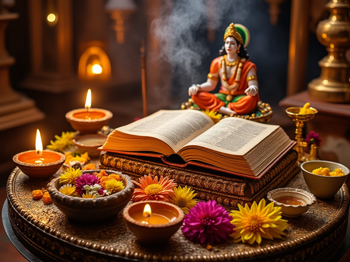The Gayatri Mantra Jaap holds deep significance in Hindu culture and spirituality:
- Divine Connection: The mantra is a powerful tool to connect with the divine, invoking the blessings of the Sun God, Savitr, who is believed to bestow life, vitality, and wisdom.
- Purification: Chanting the Gayatri Mantra purifies the mind and body, helping to cleanse negative thoughts and emotions.
- Spiritual Awakening: Regular practice of Gayatri Mantra Jaap is believed to awaken the inner consciousness and lead the devotee toward self-realization.
- Universal Prayer: It is a universal prayer that transcends all religious boundaries, focusing on the well-being and enlightenment of all beings.
- Vedic Wisdom: The mantra encapsulates the essence of Vedic wisdom, emphasizing the importance of light (knowledge) over darkness (ignorance).
- Mental Clarity: Enhances concentration, focus, and clarity of thought.
- Stress Relief: Reduces stress and anxiety by calming the mind.
- Spiritual Growth: Fosters spiritual growth and deepens one's connection with the divine.
- Energy Boost: Energizes the mind and body, filling one with positivity and vigor.
- Healing Effects: Promotes overall well-being and has a healing effect on the body.
- Emotional Balance: Helps in maintaining emotional balance and inner peace.
- Enhances Intuition: Sharpens intuition and enhances spiritual awareness.
Performing the Gayatri Mantra Jaap is a revered spiritual practice in Hinduism. Below is a step-by-step guide to performing the Gayatri Mantra Jaap:
Preparation:
- Choose a Peaceful Time and Place: Early morning during Brahma Muhurta (approximately 4:00 AM - 6:00 AM) is considered the most auspicious time for chanting. Find a clean, quiet place where you can sit undisturbed.
- Cleanliness: Take a bath and wear clean, comfortable clothes. It's advisable to wear light-colored or white clothes during the jaap.
- Posture: Sit comfortably in a cross-legged position (Padmasana or Sukhasana) facing east or north. If you cannot sit on the floor, sitting on a chair is also fine. Keep your back straight.
2. Setting the Intention (Sankalpa):
- Sankalpa: Close your eyes, take a few deep breaths, and mentally make a resolution for the number of times you will chant the mantra (108 is traditional, but you may choose a number according to your capacity).
- Invoke the Divine: You may begin by offering a prayer to Lord Ganesha (to remove obstacles) and to your Ishta Devata (personal deity), if you have one.
3. Begin the Chanting:
Om Bhur Bhuvah Swaha,
Tat Savitur Varenyam,
Bhargo Devasya Dheemahi,
Dhiyo Yo Nah Prachodayat.
-
Using a Mala (Rosary): Traditionally, a mala with 108 beads is used for counting the mantras. Hold the mala in your right hand, with the mala draped over the middle finger, and use your thumb to count each bead as you chant. Do not use the index finger. After completing one round (108 chants), if you wish to continue, turn the mala around and proceed in the opposite direction.
4. Focus and Devotion:
- Concentration: While chanting, try to focus your mind on the meaning of the mantra or on the image of the sun, as Gayatri is a solar deity. Let go of all other thoughts.
- Pronunciation: Ensure that the pronunciation of the mantra is clear and precise. The power of the mantra is enhanced by correct pronunciation and mental focus.
5. Completion of the Jaap:
- Concluding Prayer: After completing your intended number of repetitions, offer a prayer to the Divine, expressing gratitude and asking for blessings.
- Meditation: Spend a few moments in silence, meditating on the light and energy of the Gayatri. Feel the peace and divine presence within you.
- Pradakshina (Circumambulation): If you are at a temple or in front of a sacred image, you may perform a clockwise circumambulation as a mark of respect.
6. Daily Practice:
- Regularity: It's beneficial to perform the Gayatri Mantra Jaap daily or at regular intervals (like every full moon). Consistency in practice is key to reaping the spiritual benefits.
- Lifestyle Considerations: Maintain a Sattvic (pure and balanced) lifestyle, which includes eating vegetarian food, practicing truthfulness, and performing selfless service.
7. Offering Food (Naivedya):
- If possible, offer some food or water as Naivedya (sacred offering) to the divine after your Jaap, and then partake of it as Prasad (blessed food).
8. Closing:
- Aarti: You may conclude with a small Aarti (ceremony of light), using a lamp or incense.
- Dedication: Dedicate the merit of the practice to the well-being of all beings.
9. After the Jaap:
- Self-Reflection: Reflect on the practice and how you feel. Carry the peace and energy from the Jaap into your daily activities.
Tips for Effective Practice:
- Start with a smaller number of repetitions if you are new to the practice and gradually increase the count.
- Do not rush the chanting. It’s better to chant slowly and with full awareness.
- Try to practice at the same time and place each day to build a strong spiritual discipline.
This practice, when done with sincerity and devotion, is believed to bring mental clarity, spiritual enlightenment, and a sense of peace.




